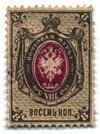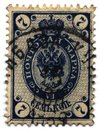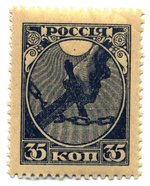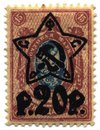Postage stamps and postal history of Russia
|
|
This a survey of the postage stamps and postal history of Russia. Traditionally, philatelists include the Soviet Union period in this category also.
| Contents |
Early postal history
Records mention a system of messengers in the 10th century. Early letters were carried in the form of a roll, with a wax or lead seal; the earliest known of these seals dates from 1079, and mentions a governor Ratibor of Tmutarakan. The earliest surviving cover was sent in 1391 from La Tana (now Azov) to Venice.
By the 16th century, the postal system included 1,600 locations, and mail took 3 days to travel from Moscow to Novgorod. In 1634, a peace treaty between Russia and Poland established a route to Warsaw, becoming Russia's first regular international service. Peter the Great enacted reforms making the postal system more uniform in its operations, and in 1716 the first post offices opened, in Moscow and Saint Petersburg.
The earliest known Russian postmark dates from 28 November 1765; it is a single line reading "ST.PETERSBOVRG" (in Latin letters), but the first official recommendation to use postmarks did not come until 1781.
Postal stationery made its first appearance in 1845, in the form of envelopes that paid the 5-kopek fee for local mail in St. Petersburg and Moscow. The idea worked well, and was extended throughout Russia on 1 December 1848.
Postage stamps
The postage stamp idea had already swept much of the world when, in September 1856, the Russian authorities decided to follow suit. The first stamps went on sale 10 December 1857, but were not valid for use until 1 January 1858. The first value was a 10-kopek to be used for letters weighing up to one lot (about 12.8 grams). It was an imperforate stamp depicting the coat of arms of Russia, and printed using typography in brown and blue. This was followed on 10 January by 20-kopek and 30-kopek perforated stamps using the same design but in different pairs of colors, along with a perforated version of the 10-kopek stamp. The paper was originally watermarked with the numeral, but this was soon abandoned, and later printings in 1858 are on regular wove paper.
A 5k stamp for local postage was introduced in 1863, and in the following year a new common design, with the arms in an oval, was introduced for 1k, 3k, and 5k values. These were used to make up complicated rates for international mail, which had previously required cash payments at the post office. After 1866 the stamps were printed on laid paper watermarked with a pattern of wavy lines and "EZGB" in Cyrillic. The "grain" of the laid paper was usually horizontal, but for a minority of each value the grain is vertical.
In September 1865, the Shlisselburg district became the first of the zemstvo offices to issue stamps; the system was officially organized by a decree of 27 August 1870.
In 1874, Russia became one of the original 22 countries forming the General Postal Union (later the Universal Postal Union).
The coat of arms design was changed in 1875, and used for 2k and 8k values, and a 7k in 1879. The 7k was also printed on revenue stamp paper watermarked with a hexagon pattern; these are quite rare.
A new issue of 14 December 1883 featured an updated design, lower values printed in a single color, and new high values - 14k, 35k, and 70k. January 1884 saw the introduction of 3.50-ruble and 7-ruble stamps, physically much larger than existing stamps.
In 1889 the designs were changed again, this time to introduce thunderbolts across the posthorns underneath the double-headed eagle, and in printings after 1902 the usual grain of the paper was changed to be vertical.
At the end of 1904 Russia issued its first semi-postal stamps. The four values were each sold at 3k over face to provide for orphans of casualties in the Russo-Japanese War.
In 1909 a new series came out, using a mix of old and new designs, all printed on unwatermarked wove paper, and with lozenges on the face to discourage postage stamp reuse.
Russia's first series of commemorative stamps appeared 2 January 1913 to mark the 300th anniversary of the Romanov dynasty. The 17 stamps featured portraits of the various Tsars, as well as views of the Kremlin, Winter Palace, and Romanov Castle. But in 1915 and 1916, as the government disintegrated under the pressures of World War I, several of the designs were printed on cardboard and used as paper money. 7k and 14k stamps were also surcharged 10k and 20k due to shortages.
Revolution
The period of the Russian Revolution is complicated philatelically; post offices across the country were thrown on their own devices, and a number of the factions and breakaway republics issued new kinds of stamps, although in some cases they seem to have been as much for publicity purposes, few genuine uses having been recorded.
Entities issuing their own stamps include:
- Armenia
- Army of the Northwest
- Batum
- Far Eastern Republic
- Georgia
- Latvia
- Siberia
- South Russia
- Transcaucasian Federated Republics
In 1917 the Provisional Government reprinted the old Tsarist designs, but sold them imperforate. The first stamps of the Russian Soviet Federated Socialist Republic appeared in 1918, as two values depicting a sword cutting a chain. While great quantities of these stamps survive, they saw little use, and used copies are worth more than mint.
Stamp_RU_1922_7500r-500px.jpg
Russian 7500r surcharge of 1922
250r stamp of 1921, surcharged to 7,500r in 1922
The next stamps appeared in 1921, after inflation had taken hold. The set's values range from 1 to 1,000 rubles. By the next year these stamps were being surcharged in various ways, with face values of up to 100,000 rubles.
A currency reform in 1922 that exchanged money at a 10,000-to-1 rate enabled new stamps in the 5r to 200r range, including a set marking the 5th anniversary of the October Revolution, Tsarist stamps surcharged with a five-pointed star containing a hammer and sickle. Stamps with portraits of a worker, peasant and soldier also appeared this year; variations on these portrait designs would continue to be issued throughout the 1920s.
Finnish occupation of Aunus
At 1919–1921 there was Aunus expedition where a group of Finnish volunteers occupied parts of East Karelia (Aunus in Finnish, Olonets Karelia in Russian). There were stamps issued for Aunus troops by local authorities. They were Finnish definitives from 1917 with overprint Aunus.
Soviet Union
Post-Soviet period
External link
- Russian postal history (http://www.rossia.com/stamps/history/history.htm)




